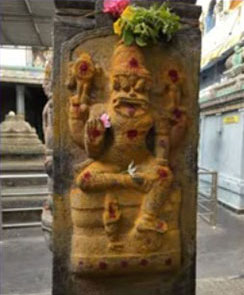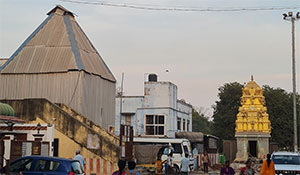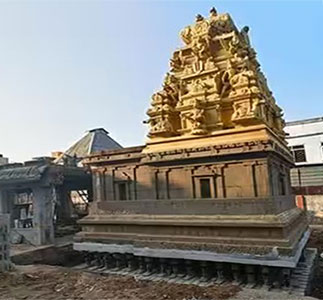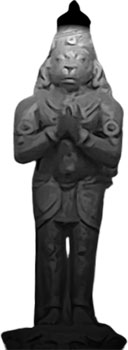
Rock-Cut Temples
 The Pallavas were renowned for the cave temples they constructed during their rule. These cave temples, also known as rock-cut temples or 'kudavarrai koil' in Tamil, are a testament to the architectural prowess of the Pallava dynasty. One of the most famous sites showcasing these rock-cut temples is Mamallapuram, also known as Mahabalipuram, located 40 km south of Chennai. The Pallava dynasty, which reigned over this region from the 6th to the 9th centuries CE, left behind these magnificent structures as their legacy. The credit for the construction of these temples in Mamallapuram is given to the first Narasimhaverman of the Pallava dynasty. As you journey from Mahabalipuram to Chengalpet, you will come across many such temples, including the Karivaradharajan temple in Vallam near Chengulpet and the Sri Lakshmi Narasimar temple in Edarkundram. One lesser-known site is located in Pallavaram, very close to the Chennai airport. Pallavaram is the modern name for Pallavapuram.
The Pallavas were renowned for the cave temples they constructed during their rule. These cave temples, also known as rock-cut temples or 'kudavarrai koil' in Tamil, are a testament to the architectural prowess of the Pallava dynasty. One of the most famous sites showcasing these rock-cut temples is Mamallapuram, also known as Mahabalipuram, located 40 km south of Chennai. The Pallava dynasty, which reigned over this region from the 6th to the 9th centuries CE, left behind these magnificent structures as their legacy. The credit for the construction of these temples in Mamallapuram is given to the first Narasimhaverman of the Pallava dynasty. As you journey from Mahabalipuram to Chengalpet, you will come across many such temples, including the Karivaradharajan temple in Vallam near Chengulpet and the Sri Lakshmi Narasimar temple in Edarkundram. One lesser-known site is located in Pallavaram, very close to the Chennai airport. Pallavaram is the modern name for Pallavapuram.
Singaperumal Koil
I recently had the privilege of visiting a rock-cut temple in Singaperumal Koil, located near Chengulpet. This place derives its name from the rock-cut temple dedicated to Sri Narasimha, the presiding deity. Formerly known as 'Sengundram,' the Sanskrit name for this place is Pataladri, with 'patala' meaning red and 'adri' meaning hill. During the Chola rule, the area was referred to as Sengundra Nadu, a part of Kalattur Kottam.
Singaperumal Temple
 Singaperumal Temple is a magnificent place of worship, featuring a large rock-cut cave that serves as the sanctum for the presiding deity Sri Narasimha. The intricate carving of the main deity and sanctum is credited to the Pallavas and dates back to the 8th century. Sri Narasimha is depicted as a four-armed deity, with two arms holding a conch and a discus at the rear. One arm is shown dispelling fear [abhya mudhra], while the other rests on the thigh.
Singaperumal Temple is a magnificent place of worship, featuring a large rock-cut cave that serves as the sanctum for the presiding deity Sri Narasimha. The intricate carving of the main deity and sanctum is credited to the Pallavas and dates back to the 8th century. Sri Narasimha is depicted as a four-armed deity, with two arms holding a conch and a discus at the rear. One arm is shown dispelling fear [abhya mudhra], while the other rests on the thigh.
What sets this temple apart is the unique posture of Lord Narasimha, with his right leg folded and left leg dangling, a rare sight in other temples dedicated to him. Another distinctive feature is the presence of a third eye on the deity's forehead, revealed when the priest lifts the Vaishnavite mark during worship.
Special anointment ceremony [thirumanjanam] is conducted on Pradosham days, adding to the spiritual significance of the temple.
Throughout history, rulers such as the Pallavas, Cholas, and Vijayanagar Samrajya have extended their patronage to this temple in various ways. This can be seen through inscriptions and the unique architectural styles present in this temple. The contributions of the Vijayanagar empire are particularly evident in the intricate details found in structures and the deepa stambha adorned with symbols like Sri Anjaneya, discus, Sri Garuda, and conch.
Circumambulating the huge rock that houses the temple is considered a sacred practice, especially on full moon days. Additionally, during the months of Margazhi (Dec-Jan) and Thai (Jan-Feb), the sun's rays align to illuminate the feet and body of Narasimha on the auspicious day of Ratha Saptami.
 The garbhagraha also houses the daily worship deity Kautukabera (कौतुकबेर) and the processional deity Prahalada Varadhan, depicted as a four-armed figure standing with Adi Sesha as the canopy. Within the rock-cut cave, shrines dedicated to the Goddess Ahobilavalli, Andal, Lakshmi Narasimha, and Vishwaksena can also be found, adding to the spiritual richness of Singaperumal Temple.
The garbhagraha also houses the daily worship deity Kautukabera (कौतुकबेर) and the processional deity Prahalada Varadhan, depicted as a four-armed figure standing with Adi Sesha as the canopy. Within the rock-cut cave, shrines dedicated to the Goddess Ahobilavalli, Andal, Lakshmi Narasimha, and Vishwaksena can also be found, adding to the spiritual richness of Singaperumal Temple.
The Pallavas, and the Kurma Avatar
The Kurma Avatar, Vishnu's second avatar as a tortoise, is a prominent motif found in Pallava art and temples. This motif, which is central to the Samudra Manthana (churning of the ocean), represents balance, strength, and stability. These qualities align perfectly with the Pallavas' quest for stability and power. It is not surprising, therefore, that in the temple at Singaperumal Koil, we can observe numerous Kurma motifs intricately carved on the ceiling and outer walls, showcasing the Pallavas' reverence for this symbol of strength and stability.
Patronage of Rulers in Temple Architecture
Throughout history, rulers such as the Pallavas, Cholas, and Vijayanagar Samrajya have extended their patronage to this temple in various ways. This can be seen through inscriptions and the unique architectural styles present in this temple. The contributions of the Vijayanagar empire are particularly evident in the intricate details found in structures such as the four-pillar mandapa in Sannidhi street and the deepa stambha adorned with symbols like Sri Anjaneya, discus, Sri Garuda, and conch.
Sri Anjaneya temple
 One notable example of Vijayanagar influence is the temple dedicated to Sri Anjaneya. Located at the end of Sannidhi street, this temple stands facing the main deity Sri Patalathri Narasimha Swamy. Despite being a separated from the main temple, is actually a part of the main temple and it holds significant importance. The temple is situated adjacent to a road known as 'Theradi Street', which has been relaid multiple times, causing the ground level of the Sri Anjaneya temple to be lower than that of the road. Recent renovations have aimed to elevate the temple without compromising its original architecture. There is a mandapam in front of this temple.
One notable example of Vijayanagar influence is the temple dedicated to Sri Anjaneya. Located at the end of Sannidhi street, this temple stands facing the main deity Sri Patalathri Narasimha Swamy. Despite being a separated from the main temple, is actually a part of the main temple and it holds significant importance. The temple is situated adjacent to a road known as 'Theradi Street', which has been relaid multiple times, causing the ground level of the Sri Anjaneya temple to be lower than that of the road. Recent renovations have aimed to elevate the temple without compromising its original architecture. There is a mandapam in front of this temple.
While the main temple and deity are facing East, Sri Anjaneya is facing west towards the main deity and offering his prayers unceasingly.
Sri Bhaktha Anjaneya
As He is facing the main deity, He is seen as a Bhaktha Anjaneya. Lord is seen standing on a lotus pedestal with His palms joined, offering obeisance to Sri Narasimha Swamy. Sri Anjaneya is seen wearing Thandai in His lotus feet, dhoti in kacham format, Kankan and keyur in arms, a few pearl garlands in bosom, yagyopavit across chest, kundal in the ears. Chubby cheeks project the bright eyes more promptly. The glowing eyes bestow unbound blessings to His devotees.
Location of the temple: "Theradi Sri Bhaktha Anjaneya Temple, Singaperumal Koil"
Experience
Praying at the Pancha Anupa Sri Patalatri Narasimha temple and offering prayers to Sri Bhaktha Anjaneya is bound to give immense peace of mind.
SRI HANUMAN THINKS DIFFERENTLY, THINKS FAST
THINKS AHEAD AND ACTS FOR SURE
Ed [May 2025]
